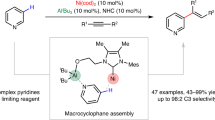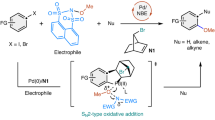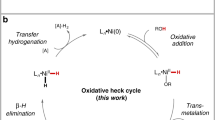Abstract
Ni-catalysed functionalization of strong sigma C–O bonds has become an innovative alternative for forging C–C bonds from simple and readily available phenol-derived precursors. However, these methodologies are poorly understood in mechanistic terms. Here we provide mechanistic knowledge about how Ni catalysts enable sp2–sp2 bond formation between aryl esters and arylzinc species by providing reliable access to on-cycle mononuclear oxidative addition species of aryl esters to Ni(0) complexes bearing monodentate phosphines with either κ1- or κ2-O binding modes. While studying the reactivity and decomposition pathways of these complexes, we have unravelled an intriguing dichotomy exerted by Zn(ii) salts that results in parasitic ligand scavenging, oxidation events and NiZn clusters. We provide evidence that coordinating solvents and ligands disrupt these processes, thus offering knowledge for designing more-efficient Ni-catalysed reactions and a useful entry point to unravel the mechanistic intricacies of related processes.

This is a preview of subscription content, access via your institution
Access options
Access Nature and 54 other Nature Portfolio journals
Get Nature+, our best-value online-access subscription
$29.99 / 30 days
cancel any time
Subscribe to this journal
Receive 12 digital issues and online access to articles
$119.00 per year
only $9.92 per issue
Buy this article
- Purchase on Springer Link
- Instant access to full article PDF
Prices may be subject to local taxes which are calculated during checkout







Similar content being viewed by others
Data availability
Experimental procedures and characterization data for the catalysts and the synthesized compounds are included in the Supplementary Information. Crystallographic data are available from the Cambridge Crystallographic Data Centre with the following codes: 5a (CCDC 2017448), 5b (CCDC 2017449), 5c (CCDC 2017447), 6a (CCDC 2017442), 8 (CCDC 2017444), 10 (CCDC 2017446), 11 (CCDC 2017445), 12 (CCDC 2017450), 13 (CCDC 2017441), 14 (CCDC 2017443) and 17 (CCDC 2017440). Other data are available from the corresponding author upon request.
References
Tasker, S. Z., Standley, E. A. & Jamison, T. F. Recent advances in homogeneous nickel catalysis. Nature 509, 299–309 (2014).
Hazari, N., Melvin, P. R. & Beromi, M. M. Well-defined nickel and palladium precatalysts for cross-coupling. Nat. Rev. Chem. 1, 17–25 (2017).
Diccianni, J. B. & Diao, T. Mechanisms of nickel-catalyzed cross-coupling reactions. Trends Chem. 1, 830–844 (2019).
de Meijere, A. & Diederich, F. Metal-Catalyzed Cross-Coupling Reactions (Wiley, 2008).
Rosen, B. M. et al. Nickel-catalyzed cross-couplings involving carbon–oxygen bonds. Chem. Rev. 111, 1346–1416 (2011).
Desnoyer, A. N. & Love, J. A. Recent advances in well-defined, late transition metal complexes that make and/or break C–N, C–O and C–S Bonds. Chem. Soc. Rev. 46, 197–238 (2017).
Zarate, C., van Gemmeren, M., Somerville, R. J. & Martin, R. Phenol derivatives: modern electrophiles in cross-coupling reactions. Adv. Organomet. Chem. 66, 143–222 (2016).
Su, B., Cao, Z. C. & Shi, Z. J. Exploration of earth-abundant transition metals (Fe, Co, and Ni) as catalysts in unreactive chemical bond activations. Acc. Chem. Res. 48, 886–896 (2015).
Tobisu, M. & Chatani, N. Cross-couplings using aryl ethers via C–O bond activation enabled by nickel catalysts. Acc. Chem. Res. 48, 1717–1726 (2015).
Ishizu, J., Yamamoto, T. & Yamamoto, A. Selective cleavage of C–O bonds in esters through oxidative addition to nickel (0) complexes. Chem. Lett. 5, 1091–1094 (1976).
Wenkert, E., Michelotti, E. L. & Swindell, C. S. Nickel-induced conversion of carbon-oxygen into carbon-carbon bonds. One-step transformations of enol ethers into olefins and aryl ethers into biaryls. J. Am. Chem. Soc. 101, 2246–2247 (1979).
Li, B. J. et al. Cross-coupling of aryl/alkenyl pivalates with organozinc reagents through nickel-catalyzed C—O bond activation under mild reaction conditions. Angew. Chem. Int. Ed. 47, 10124–10127 (2008).
Quasdorf, K. W., Tian, X. & Garg, N. K. Cross-coupling reactions of aryl pivalates with boronic acids. J. Am. Chem. Soc. 130, 14422–14423 (2008).
Guan, B., Wang, Y., Li, B., Yu, D. & Shi, Z. Biaryl construction via Ni-catalyzed C–O activation of phenolic carboxylates. J. Am. Chem. Soc. 130, 14468–14470 (2008).
Cornella, J., Gómez-Bengoa, E. & Martin, R. Combined experimental and theoretical study on the reductive cleavage of inert C–O bonds with silanes: ruling out a classical Ni(0)/Ni(II) catalytic couple and evidence for Ni(I) intermediates. J. Am. Chem. Soc. 135, 1997–2009 (2013).
Somerville, R. J., Hale, L. V. A., Gómez-Bengoa, E., Burés, J. & Martin, R. Intermediacy of Ni–Ni species in sp2 C–O bond cleavage of aryl esters: relevance in catalytic C–Si bond formation. J. Am. Chem. Soc. 140, 8771–8780 (2018).
Muto, K., Yamaguchi, J., Lei, A. & Itami, K. Isolation, structure, and reactivity of an arylnickel(II) pivalate complex in catalytic C–H/C–O biaryl coupling. J. Am. Chem. Soc. 135, 16384–16387 (2013).
Guan, B. T. et al. Methylation of arenes via Ni-catalyzed aryl C–O/F activation. Chem. Commun. 1437–1439 (2008).
Dankwardt, J. W. Nickel-catalyzed cross-coupling of aryl Grignard reagents with aromatic alkyl ethers: an efficient synthesis of unsymmetrical biaryls. Angew. Chem. Int. Ed. 43, 2428–2432 (2004).
Li, Z., Zhang, S. L., Fu, Y., Guo, Q. X. & Liu, L. Mechanism of Ni-catalyzed selective C–O bond activation in cross-coupling of aryl esters. J. Am. Chem. Soc. 131, 8815–8823 (2009).
Hong, X., Liang, Y. & Houk, K. N. Mechanisms and origins of switchable chemoselectivity of Ni-catalyzed C(aryl)–O and C(acyl)–O activation of aryl esters with phosphine ligands. J. Am. Chem. Soc. 136, 2017–2025 (2014).
Quasdorf, K. W. et al. Suzuki–Miyaura cross-coupling of aryl carbamates and sulfamates: experimental and computational studies. J. Am. Chem. Soc. 133, 6352–6363 (2011).
Haas, D., Hammann, J. M., Greiner, R. & Knochel, P. Recent developments in Negishi cross-coupling reactions. ACS Catal. 6, 1540–1552 (2016).
Tortajada, A., Juliá-Hernández, F., Börjesson, M., Moragas, T. & Martin, R. Transition-metal-catalyzed carboxylation reactions with carbon dioxide. Angew. Chem. Int. Ed. 57, 15948–15982 (2018).
Everson, D. A. & Weix, D. J. Cross-electrophile coupling: principles of reactivity and selectivity. J. Org. Chem. 79, 4793–4798 (2014).
Weix, D. J. Methods and mechanisms for cross-electrophile coupling of Csp2 halides with alkyl electrophiles. Acc. Chem. Res. 48, 1767–1775 (2015).
Diccianni, J., Lin, Q. & Diao, T. Mechanisms of nickel-catalyzed coupling reactions and applications in alkene functionalization. Acc. Chem. Res. 53, 906–919 (2020).
Desnoyer, A. N. et al. Exploring regioselective bond cleavage and cross-coupling reactions using a low-valent nickel complex. Chem. Eur. J. 22, 4070–4077 (2016).
Chatupheeraphat, A. et al. Ligand-controlled chemoselective C(acyl)–O bond vs C(aryl)–C bond activation of aromatic esters in nickel catalyzed C(sp2)-C(sp3) cross-couplings. J. Am. Chem. Soc. 140, 3724–3735 (2018).
Guo, L. & Rueping, M. Decarbonylative cross-couplings: nickel catalyzed functional group interconversion strategies for the construction of complex organic molecules. Acc. Chem. Res. 51, 1185–1195 (2018).
Brauer, D. J. & Krüger, C. Bonding of aromatic hydrocarbons to nickel(0). Structure of bistricyclohexylphosphine (1,2-η2-anthracene)nickel(0)-toluene. Inorg. Chem. 16, 884–891 (1977).
Isaeva, L. S., Drogunova, G. I., Peregudov, A. S. & Kravtsov, D. N. Arylbis(triphenylphosphinyl)nickel carboxylates. Russ. Chem. Bull. 37, 153–157 (1988).
Christian, A. H., Müller, P. & Monfette, S. Nickel hydroxo complexes as intermediates in nickel-catalyzed Suzuki–Miyaura cross-coupling. Organometallics 33, 2134–2137 (2014).
Chatt, J. & Shaw, B. L. Alkyls and aryls of transition metals. Part III. Nickel(II) derivatives. J. Chem. Soc. 1718–1729 (1960).
Standley, E. A., Smith, S. J., Müller, P. & Jamison, T. F. A broadly applicable strategy for entry into homogeneous nickel(0) catalysts from air-stable nickel(II) complexes. Organometallics 33, 2012–2018 (2014).
Campeau, L. C. & Hazari, N. Cross-coupling and related reactions: connecting past success to the development of new reactions for the future. Organometallics 38, 3–35 (2019).
Diccianni, J. B., Hu, C. T. & Diao, T. Insertion of CO2 mediated by a (xantphos)NiI-alkyl species. Angew. Chem. Int. Ed. 58, 13865–13868 (2019).
Witzke, R. J. & Tilley, T. D. A two-coordinate Ni(I) silyl complex: CO2 insertion and oxidatively-induced silyl migrations. Chem. Commun. 55, 6559–6562 (2019).
Lin, Q. & Diao, T. Mechanism of Ni-catalyzed reductive 1,2-dicarbofunctionalization of alkenes. J. Am. Chem. Soc. 141, 17937–17948 (2019).
Bontempelli, G., Corain, B. & de Nardo, L. Electrochemical reduction of dicyanobis(tertiary phosphine)nickel(II) complexes. J. Chem. Soc. Dalt. Trans. 1887–1891 (1977).
Crabtree, R. H. The Organometallic Chemistry of the Transition Metals 6th edn (John Wiley & Sons, 2014).
Messinis, A. M. et al. The highly surprising behaviour of diphosphine ligands in iron-catalysed Negishi cross-coupling. Nat. Catal. 2, 123–133 (2019).
Eckert, P. & Organ, M. G. The role of LiBr and ZnBr2 on the cross-coupling of aryl bromides with Bu2Zn or BuZnBr. Chem. Eur. J. 25, 15751–15754 (2019).
Oeschger, R. J. & Chen, P. A heterobimetallic Pd–Zn complex: study of a d8–d10 bond in solid state, in solution, and in silico. Organometallics 36, 1465–1468 (2017).
Böck, K., Feil, J. E., Karaghiosoff, K. & Koszinowski, K. Catalyst activation, deactivation, and degradation in palladium-mediated Negishi cross-coupling reactions. Chem. Eur. J. 21, 5548–5560 (2015).
Abdiaj, I. et al. Photoinduced palladium-catalyzed Negishi cross-couplings enabled by the visible-light absorption of palladium–zinc complexes. Angew. Chem. Int. Ed. 57, 13231–13236 (2018).
Chass, G. A. et al. Density functional theory investigation of the alkyl–alkyl Negishi cross-coupling reaction catalyzed by N-heterocyclic carbene (NHC)–Pd complexes. Chem. Eur. J. 15, 4281–4288 (2009).
Álvarez, R., de Lera, A. R., Aurrecoechea, J. M. & Durana, A. Bimetallic intermediates in the formation of nucleophilic allenylzincs from allenylpalladiums: a DFT study. Organometallics 26, 2799–2802 (2007).
García-Melchor, M. et al. Cationic intermediates in the Pd-catalyzed Negishi coupling. Kinetic and density functional theory study of alternative transmetalation pathways in the Me–Me coupling of ZnMe2 and trans-[PdMeCl(PMePh2)2]. J. Am. Chem. Soc. 133, 13519–13526 (2011).
Johansson Seechurn, C. C. C., Kitching, M. O., Colacot, T. J. & Snieckus, V. Palladium-catalyzed cross-coupling: a historical contextual perspective to the 2010 Nobel prize. Angew. Chem. Int. Ed. 51, 5062–5085 (2012).
Negishi, E. I. Magical power of transition metals: past, present, and future (Nobel Lecture). Angew. Chem. Int. Ed. 50, 6738–6764 (2011).
Craciun, R., Vincent, A. J., Shaughnessy, K. H. & Dixon, D. A. Prediction of reliable metal–PH3 bond energies for Ni, Pd, and Pt in the 0 and +2 oxidation states. Inorg. Chem. 49, 5546–5553 (2010).
Mohadjer Beromi, M., Brudvig, G. W., Hazari, N., Lant, H. M. C. & Mercado, B. Q. Synthesis and reactivity of paramagnetic nickel polypyridyl complexes relevant to C(sp2)-C(sp3) coupling reactions. Angew. Chem. Int. Ed. 58, 6094–6098 (2019).
Mohadjer Beromi, M. et al. Mechanistic study of an improved Ni precatalyst for Suzuki−Miyaura reactions of aryl sulfamates: understanding the role of Ni(I) species. J. Am. Chem. Soc. 139, 922–936 (2017).
Zhang, S. Q. et al. Mechanism and origins of ligand-controlled stereoselectivity of Ni-catalyzed Suzuki–Miyaura coupling with benzylic esters: a computational study. J. Am. Chem. Soc. 139, 12994–13005 (2017).
Correa, A. & Martin, R. Ni-catalyzed direct reductive amidation via C–O bond cleavage. J. Am. Chem. Soc. 136, 7253–7256 (2014).
Correa, A., León, T. & Martin, R. Ni-catalyzed carboxylation of C(sp2)– and C(sp3)–O bonds with CO2. J. Am. Chem. Soc. 136, 1062–1069 (2014).
Isshiki, R., Inayama, N., Muto, K. & Yamaguchi, J. Ester transfer reaction of aromatic esters with haloarenes and arenols by a nickel catalyst. ACS Catal. 10, 3490–3494 (2020).
Hofstra, J. L., Poremba, K. E., Shimozono, A. M. & Reisman, S. E. Nickel-catalyzed conversion of enol triflates into alkenyl halides. Angew. Chem. Int. Ed. 58, 14901–14905 (2019).
Gu, J., Wang, X., Xue, W. & Gong, H. Nickel-catalyzed reductive coupling of alkyl halides with other electrophiles: concept and mechanistic considerations. Org. Chem. Front. 2, 1411–1421 (2015).
Acknowledgements
We would like to thank the Institut Català d'Investigació Química (ICIQ) and the European Regional Development Fund (FEDER/MCI) (AEI/PGC2018-096839-B-I00) for financial support. C.S.D. thanks the European Union’s Horizon 2020 under the Marie Curie PREBIST grant agreement 754558, and R.J.S. thanks “la Caixa” Foundation (ID 100010434) under agreement LCF/BQ/SO15/52260010 for financial support. We sincerely thank E. Escudero, M. Martinez and J. Benet for X-ray crystallographic data.
Author information
Authors and Affiliations
Contributions
C.S.D. designed and carried out all of the chemical reactions and analysed the data. R.J.S. participated in preliminary experiments. C.S.D. and R.M. conceived and designed the experiments and prepared the manuscript. All authors contributed to discussions, commented and edited the manuscript.
Corresponding author
Ethics declarations
Competing interests
The authors declare no competing interests.
Additional information
Peer review information Nature Catalysis thanks the anonymous reviewers for their contribution to the peer review of this work.
Publisher’s note Springer Nature remains neutral with regard to jurisdictional claims in published maps and institutional affiliations.
Supplementary information
Supplementary Information
Supplementary Methods, Figs. 1–50 and Tables 1–3.
Supplementary Data
CIF (crystallographic data) of structure 5a.
Supplementary Data
CIF (crystallographic data) of structure 5b.
Supplementary Data
CIF (crystallographic data) of structure 5c.
Supplementary Data
CIF (crystallographic data) of structure 6a.
Supplementary Data
CIF (crystallographic data) of structure 8.
Supplementary Data
CIF (crystallographic data) of structure 10.
Supplementary Data
CIF (crystallographic data) of structure 11.
Supplementary Data
CIF (crystallographic data) of structure 12.
Supplementary Data
CIF (crystallographic data) of structure 13.
Supplementary Data
CIF (crystallographic data) of structure 14.
Supplementary Data
CIF (crystallographic data) of structure 17.
Rights and permissions
About this article
Cite this article
Day, C.S., Somerville, R.J. & Martin, R. Deciphering the dichotomy exerted by Zn(ii) in the catalytic sp2 C–O bond functionalization of aryl esters at the molecular level. Nat Catal 4, 124–133 (2021). https://doi.org/10.1038/s41929-020-00560-3
Received:
Accepted:
Published:
Issue Date:
DOI: https://doi.org/10.1038/s41929-020-00560-3
This article is cited by
-
One electron is better than two
Nature Catalysis (2023)
-
Valve turning towards on-cycle in cobalt-catalyzed Negishi-type cross-coupling
Nature Communications (2023)
-
Elucidating electron-transfer events in polypyridine nickel complexes for reductive coupling reactions
Nature Catalysis (2023)
-
Modulation of metal species as control point for Ni-catalyzed stereodivergent semihydrogenation of alkynes with water
Nature Communications (2023)



